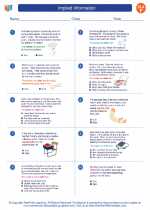Implied Information
Implied information refers to the details and ideas that are suggested or hinted at in a text, but are not explicitly stated. It requires the reader to make inferences based on the information that is given. Authors often use implied information to add depth and complexity to their writing, allowing readers to engage with the text on a deeper level.
Examples of Implied Information
1. In a story, the author may not explicitly state a character's emotions, but the reader can infer how the character is feeling based on their actions and dialogue.
2. A poem may use descriptive language to imply the setting or time period without directly stating it.
3. In a persuasive essay, the author may imply the benefits of a certain course of action without explicitly stating them.
Study Guide for Implied Information
- Identifying Clues: Look for words, phrases, or actions in the text that suggest certain ideas or details without directly stating them.
- Making Inferences: Practice making educated guesses about the implied information based on the evidence provided in the text.
- Contextual Analysis: Consider the context of the text, including the characters, setting, and events, to help deduce implied information.
- Discussion: Engage in discussions with others about the implied information in a text to gain different perspectives and insights.
- Practice Questions: Answer questions that require you to infer implied information from a passage, story, or poem.
By understanding how to identify and interpret implied information, readers can gain a deeper understanding of the text and appreciate the nuances of the author's writing.
[Implied Information] Related Worksheets and Study Guides:
.◂English Language Arts Worksheets and Study Guides Sixth Grade. Implied Information

 Worksheet/Answer key
Worksheet/Answer key
 Worksheet/Answer key
Worksheet/Answer key
